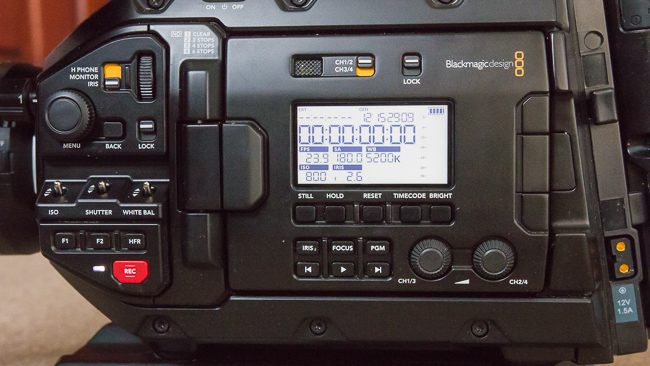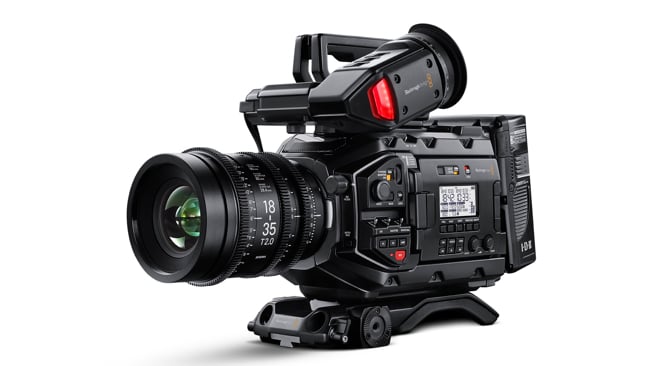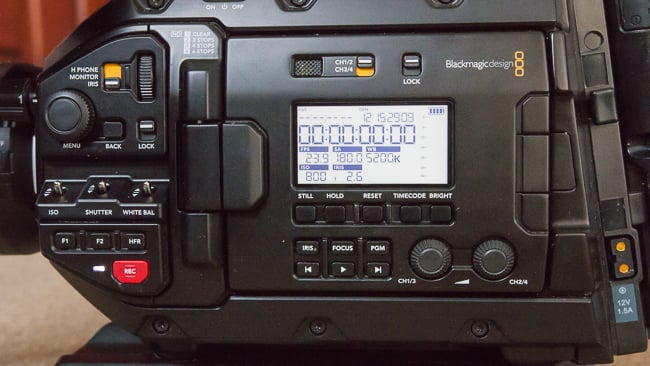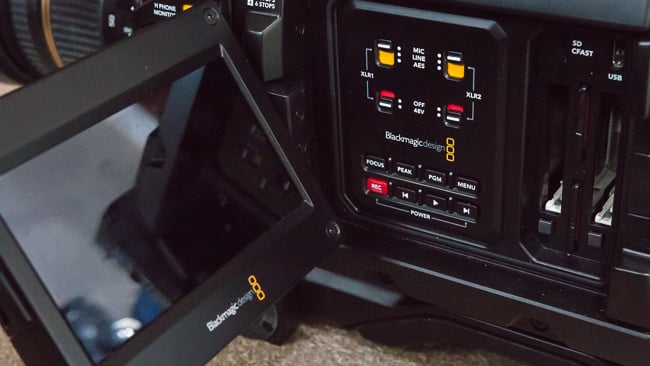
 The Blackmagic Ursa Mini Pro: Add all the bells and whistles you need and you get a lot of camera for around $9K
The Blackmagic Ursa Mini Pro: Add all the bells and whistles you need and you get a lot of camera for around $9K
Blackmagic has an excellent reputation for incorporating user feedback into the latest iterations of its cameras and, with the addition of NDI filters and some really well thought-out ergonomics, the $6000 Blackmagic Ursa Mini Pro carries on the tradition. All in all, it is a lot of camera for the money.
Like all companies that make progress, the design of the cameras from Blackmagic has matured. First came the Ursa, the company’s first attempt at a more traditional form factor. This wasn’t without its quirks, and the sheer weight of it was offputting to some. BMD answered this criticism with the Ursa Mini; a camera that offered very similar performance, but in a much lighter, more compact form. BMD had its winner.
Again, though, the Ursa Mini wasn’t without its idiosyncrasies. If only the controls were more accessible, and if only it could have built in ND filters. Then we would have had the perfect camera.
It’s all about evolution and, now we have the Ursa Mini Pro. Place the new Pro version next to the original Ursa Mini, and you can certainly see where the ‘pro’ aspect comes in. Looked at separately and the changes look superficial. Looking at the two at the same time, and the original Mini looks basic in comparison.
Like all Blackmagic cameras, the Ursa Mini Pro is built to last. At 2.3kg for the body, it is only fractionally heavier than one of its closest rivals but feels much better built, with an all-metal chassis and body. Aesthetically it looks great too. So, what’s changed about this version of the Ursa Mini over previous iterations?
NDI Filters
One of the most requested features is up front. The ND filters. These are available in steps of clear, 2 stops, 4 stops, and 6 stops. Much to my relief these are also IR filtered as well and didn’t look to produce any noticeable colour cast during use.
The next thing you notice is the number of both rocker switches and buttons. There are three rocker switches up front, which cycle individually through functions such as ISO, Shutter, and White Balance. Along with the all-important record button, and assignable function buttons, these are all located right where you can access them when operating off the shoulder. A large iris control dial is also close by for DSLR style lens operation. There is also a rocker switch to turn the camera on and off (though if for some reason the switch breaks you can still turn the camera on and off by holding down the Rec and skip forward buttons behind the flip-out LCD).

On the Mini Pro, that was a 4” display compared with a 5” version on the previous cameras. On preceding versions of the Ursa, this display could get in the way because some important controls such as audio volume control, could not be accessed when it was closed up. The Mini Pro changes all that by featuring a separate display on the outside that shows VU meters, timecode, frame rate, external and internal timecode, and other important information at a glance. This display also features selectable backlight levels to make viewing it easier in different lighting conditions.
This is a huge step forward for the Ursa design. Rotary dials to control audio levels are also present to hand. Like the previous cameras, these have no hard stops and infinitely rotate.
Open the LCD out, and you have access to two CFast and two SD card slots, and audio input selections amongst other things.

How does it stack up in use?
Startup time for the Ursa Mini Pro is between 3 to 5 seconds, so it isn’t instantaneous. The monitoring touchscreen LCD is bright and easy to see, and to judge focus on. While the provided 1080p OLED viewfinder was also very clear and pleasing to use. I found one niggling foible with regard to the use of the OLED viewfinder, which may be a small bug in the firmware. The viewfinder can have the camera information fed to it by turning the display information on through the front SDI port. If I relied on the OLED display itself to provide the current settings information rather than turning on the “status text” output for the front SDI port, then the OLED gave me the wrong shutter speed in HFR modes. So make sure that you have the “status text” output set to on for the front SDI port until this bug is quashed.
Using this version of the Ursa Mini compared to the previous model is a lot more convenient. The simple addition of ND filters allows things to move along at a less fussy pace, and operating off the shoulder is finally fun. A large accessible clickable rotary dial also allows lots of the camera settings such as framerate, zebra levels, and much more to be adjusted on the fly without needing to take the camera down.
Incidentally, the camera with the supplied Sigma 18-35mm lens was nicely balanced while shoulder-mounted. The comparative lightness of the camera means that fatigue should be rare. The important buttons and switches are to hand, and make a positive movement and click when pressed.
One thing that I liked about the OLED viewfinder was its adjustability. It can be made to slide out quite a way; enough in fact that I am sure that left eyed operators might finally have a solution that works for them. While the optional shoulder-mount does not have a quick release slide mechanism, the unit can be unbolted and placed much further fore and aft to allow balancing with heavier or lighter lenses.
One small issue is that the main LCD monitor display still cannot be rotated 180 degrees, and, at some angles, it can obscure some of the operational buttons and controls on the side of the camera.
Power consumption was pretty good. With a 95w/h IDX Enduro giving roughly 2hrs operating time give or take. The Mini Pro can record to either CFast 2.0 or SDXC cards, which is a welcome feature, given the cost of CFast 2.0 cards —. especially when you consider that 128GB, even in Raw 3:1 mode at full 4.6K resolution, will only get you 12 minutes of recording at 23.98p. To flip between the two recording media types you need to flick a tiny switch near the top of the card slots.
The addition of SD card recording is a welcome one. But how much this will save you on recording media costs will depend on exactly what you want to record onto them. In order to get the best from the Ursa Mini Pro, you will need the top-end UHSII cards, and this may not be as economical as you might think.
Following Action
While using the camera, I found that there was a small delay between what was shown on the LCD and reality. All cameras have this and some are better than others. Whilst the delay was noticeable on this camera, I didn’t find it to adversely affect my ability to follow action, although clearly if this could be minimised it would be to the cameras (and the operators’) advantage. It’s not a deal breaker, but it is something to be aware of and could be an issue with very fast action.
On the audio side, the camera appeared to give more than enough input gain to get decent levels. The physical audio level dials appeared to give a pretty instantaneous response to volume adjustments. For the most part, you will be watching the real time feedback of the VU meters to judge levels.
These aren’t the quietest circuits around, but they certainly aren’t the worst either. I have uploaded a short sample for readers to listen to here, recorded with a Sennheiser MKE 2 P lav mic. This was not taken in the quietest of rooms, but should still give you an idea of recording quality, if you can excuse my droning voice!
The Ursa Mini Pro displays and records timecode. It appears that you can switch between recording clip timecode and time of day by pressing the timecode button. This isn’t immediately clear because the camera always shows you time of day timecode at the top of the external LCD display. It isn’t clear what the reset button does since nothing seems to happen when pressed. Perhaps more capability is forthcoming in a future firmware update.
The camera also accepts reference timecode in. Speaking of which, both this and the neighbouring SDI in/out sockets are conveniently placed, although it would be nice to have some rubber covers in place to stop dust and dirt getting onto them when not in use.
Picture quality
The quality of the 4.6K Ursa is well documented and, as far as I can see, nothing has changed between this version of the camera and the previous 4.6K iteration; if you are familiar with the existing 4.6K line you will know what to expect. Frankly, I love the colours that are produced by all of the Blackmagic cameras. There is no other camera available on the market that shoots this sort of quality or resolution for the same money.
Like other BMD cameras, the Mini Pro is not a low-light performer, and there is no in-camera noise reduction. Such processes need to be carried out in applications such as DaVinci Resolve, which performs a sterling job of cleaning up noise issues from all the BMD cameras.
The key here is shooting with enough light. If you want a low-light monster you need to be looking elsewhere. But if you want to be shooting spectacular imagery in most normal lighting situations, you’ll do just fine. And I kid you not, this camera is very capable of some incredible imagery.
Blackmagic Ursa Mini Pro Conclusions
The Ursa Mini Pro costs $5995 for the body. In order to get the very best, and most versatile use from it, you will want the OLED viewfinder and possibly the shoulder-mount kit. You’ll also need a good battery system as well, with at least four batteries, maybe more depending on how intensive your days are. This could add a third again to the cost to make an operational system.
It’s not a small investment by any stretch, but for one of its nearest rivals, you will be investing possibly well over $12,000 inc recording media to get the same raw recording capabilities. And it will be in a much more cumbersome set-up.
In addition, if you wish to use different lens types, including B4 and PL, the Ursa Mini Pro can have its lens mounts changed over quickly and easily. The different lens mounts are relatively inexpensive compared to many of the alternative lens adaptor solutions available for rival cameras.
Al in all, the Blackmagic Ursa Mini Pro is a vast improvement in terms of practicality over the previous versions of the camera. It allows a versatility of recording settings and media types to suit all budgets, and therefore allows the owner to upgrade his or her recording capabilities as their budget allows, without needing to purchase any extra add-ons other than the recording media itself.
Even without the optional OLED viewfinder and shoulder mount, you could build yourself a usable system (assuming you have lenses) for just over $8000. That’s pretty amazing value compared to other systems. Whats's more, if history is any judge, it is likely that its capabilities will only get better as new firmware is released too.
Tags: Production


Comments